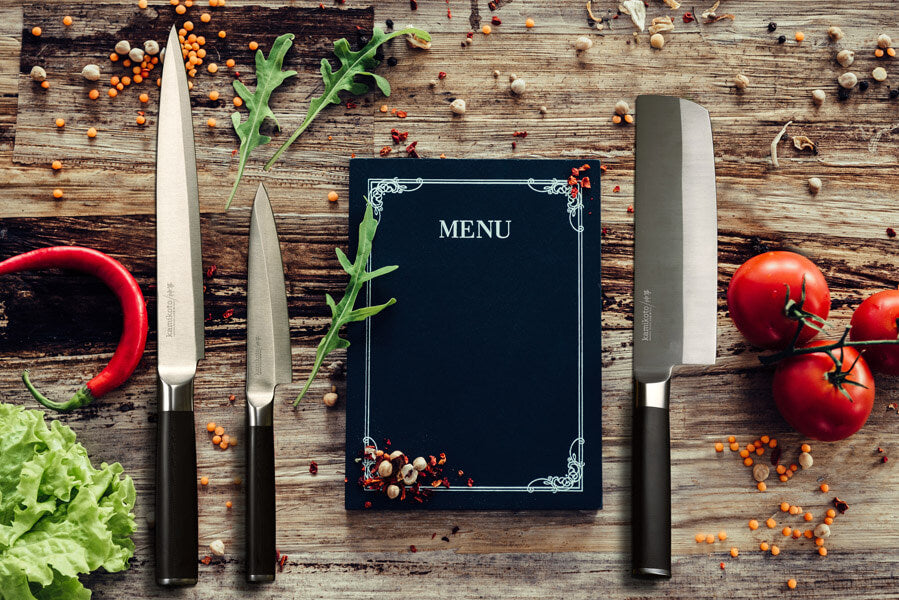
Over time the meaning of terms contained in menus has evolved immensely. In fact, it has changed so much that in different parts of the world the same term means two different things! This can be very confusing for diners, especially for those travelling between countries.
The following is an explanation of some key menu terms. It is hoped this may assuage any confusion concerning meaning while also serving to further develop one’s menu knowledge base.
What is an entrée?
To work out the meaning of the word entrée, the first thing to note is where the term is being used.
In modern-day France, the word refers to a small portion of plated food that comes before the main meal. This is also the case in some parts of the UK, Australia and a few other English-speaking nations. However, some fine dining menus in these countries also refer to entreés as starters or appetizers.
In the United States and some parts of Canada, the word entrée refers to the main meal itself.
Why is an entrée a main meal in one country but a starter in another?
The reason for the difference in meaning has historic, and somewhat complicated, roots. In French, the word’s literal translation is ‘entrance’. However, in elaborate French ‘classical order’ menus - those featuring many courses - it was never the first item served. Instead, the entrée came after the soup and hors d'oeuvres, just before the hot roast.
Over centuries, the use of the term entrée went through a number of incarnations. This was mainly due to changes in the way food was served during war time and/or for religious purposes. In modern France, the entrée is now considered the first small course served before the main meal.
The United States followed the French ‘classical order’ menu until the end of the 19th century. But at the beginning of the 20th century, there was a shift from serving multiple courses of food to a lesser amount. This is when Americans began referring to the main course in a menu as the entrée.
What is the difference between an entrée, appetizer and hors d'oeuvre?
While the differences relating to the term entrée are dealt with above, the terms appetizer and hors d’oeuvre also cause an amount of confusion. In some countries, the terms can be used interchangeably but in traditional usage, there is a distinct difference between them.
Hors d'oeuvre
An hors d’oeuvre is a type of finger food that can be consumed in just one bite. It is passed around to guests before they are seated for formal dining. Hors d’oeuvres are also known as canapes and may be either hot or cold.
In French, the word translates to ‘outside the meal’. It stands to reason then that the dish served is separate to the standard courses (first, second and third course).
Examples
- Small filled vol au vents
- Pickled or deviled eggs
- Smoked salmon on toast
- Stuffed mushrooms
- Small skewered items (meats, vegetable, cheeses)
- Caviar
- Dumplings
Appetizer
These are often served when guests are seated for the formal meal. They are a little bigger in size than hors d’oeuvres and often presented on a platter for guests to share. In the US, Canada and a few other English speaking nations, these are also referred to as starters.
Examples
- Caprese salad
- Mixed charcuterie & cheeses
- Bruschetta
- Finger sandwiches
- Quiche tart
Types of menus
In the current culinary world, there has been a distinct shift from a la carte dining and three-course menus to those featuring small and large plates designed to be shared. However, the tradition of a three-course menu still persists in many fine dining establishments across the world.
A three-course menu includes:
Referred to as the entrée in France and some English speaking nations, but elsewhere as an appetizer or starter
The main meal, referred to as entrée in the United States and Canada
The third meal, often containing sweets or baked goods such as ice cream or cakes
Other menu types
- A la carte: diners can order freely from a list of dishes
- Set menu: a set number of courses for a fixed price
- Dessert menu: a separate menu featuring desserts
What is a set menu?
Generally speaking, a set menu features a defined number of courses for a stated price. In the past, it comprised just three courses but today, it can encompass any number. It is also referred to by a number of different names, ie a degustation or a tasting menu.
In a set menu, diners can choose from a limited number of options according to their taste. It is often the most cost-effective way to dine, rather than choosing to order items a la carte.
What is a dessert menu and why is it often separate from the main menu?
For many diners, desserts are the main attraction. While they enjoy their first and second courses, they look forward to their third course with the most anticipation and expectation. As such, many renowned restaurants are known for their bold, inventive and comprehensive desserts menus that entice those with a sweet-tooth.
A dessert menu is often presented in addition to a main menu as in many cases, the chef responsible for it is entirely different. Most fine dining restaurants employ a professional pastry chef to create and cook a signature dessert menu for their guests. They utilize their full set of refined plating skills to plate desserts worthy of acclaim and awe.
Dessert menus are carefully planned to offer a variety of options to tempt those who like something sweet, as well as those with a more savory tooth. Sticking to classic combinations is important but extending flavors is also an masterful way to ensure diners end their meal on a high.
Some dessert menu essentials:
- Chocolate – it is a staple and should be included in some form
- Fruit – a good element to use for those who prefer a healthier or more refreshing option
- Ice cream – popular in just about any form from traditional to gelato to sorbet to deep fried
- Pastry – can be combined with any number of ingredients such as fruit or custard
- Cake – an always-popular option with an infinite number varieties to choose from
Example dessert items:
- Crème brûlée
- Citrus or berry based cheesecake
- Chocolate fondant
- Semifreddo or panna cotta
- Bombe/Baked Alaska
- Cuisine based desserts – Spanish churros, Italian gelato, French tarte tatin, Japanese wagashi and so on
An explanation of further menu terms:
When ordering from a menu, there are a few other terms one might come across that may benefit from further explanation.
What is a main menu item?
Once again depending on where one is dining, a main menu item is termed as an entrée or the main meal/course. It is the star of the show, with all preceding courses designed to complement – rather than detract from – it.
The main meal is the heaviest or most complex course. It usually features a protein (or in the case of a vegetarian cuisine a ‘hero’ vegetable) and can come with selection of vegetables and/or sauces.
What is meant by a side?
A side dish is typically served alongside the main meal in a separate bowl or plate. It is often ordered in addition to a la carte items or a standard three courses, but may accompany the main meal within a set menu. A side can be any small item that adds to the main course and varies according to cuisine.
Examples
- Salad
- Vegetables
- French fries
- Small pasta dish (ie macaroni and cheese)
- Rice
- Couscous
- Garlic bread, rotis or other bread-based items
This has been a brief explanation of the different terms and meanings inherent in the language of menus. As the culinary world has changed, many new menu terms have come into existence and as a professional chef, it is both exciting and important to continually keep abreast of these to further hone one’s skills.


